Blog & Latest Updates
Fly Fishing Articles
Insects by Common Name


First trout of 2021!
Friday I drove from the Seattle area out to Yakima, Washington, where a FEMA-run Covid vaccination clinic has so many extra doses and appointments that they're eagerly offering them to people who aren't yet officially eligible. (Washington is one of the last states to open the vaccine to everybody.) I'm looking forward to being able to safely travel on airplanes again and have at least a couple exciting fishing trips planned for this summer.
For now, I just wanted to catch the first fish of the year on my drive home via the Yakima Canyon.

Action on the Yakima was slow, and I'm consistently frustrated there by the difficult access to good spots from the road-side bank. But I did see one single rise, then caught the fish on a nymph.

It's a start!
I also collected quite a few nymphs as an excuse to have some fun with the new microscope I got last fall. The highlight was probably finding a specimen of Heptagenia pulla, which isn't known from Washington or neighboring states.
Photos by Troutnut from the Yakima River in Washington

StateWashington
LocationYakima River
Date TakenApr 9, 2021
Date AddedApr 11, 2021
AuthorTroutnut
CameraNIKON 1 AW1
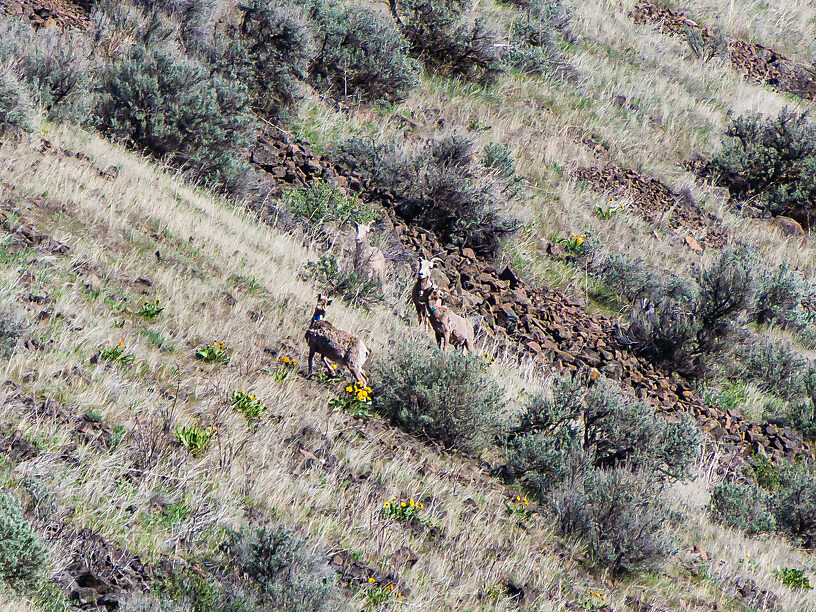
These bighorn ewes were watching over the Yakima as I fished.
StateWashington
LocationYakima River
Date TakenApr 9, 2021
Date AddedApr 11, 2021
AuthorTroutnut
CameraNIKON 1 AW1

My first trout of 2021! Not a big one, but a start.
StateWashington
LocationYakima River
Date TakenApr 9, 2021
Date AddedApr 11, 2021
AuthorTroutnut
CameraNIKON 1 AW1
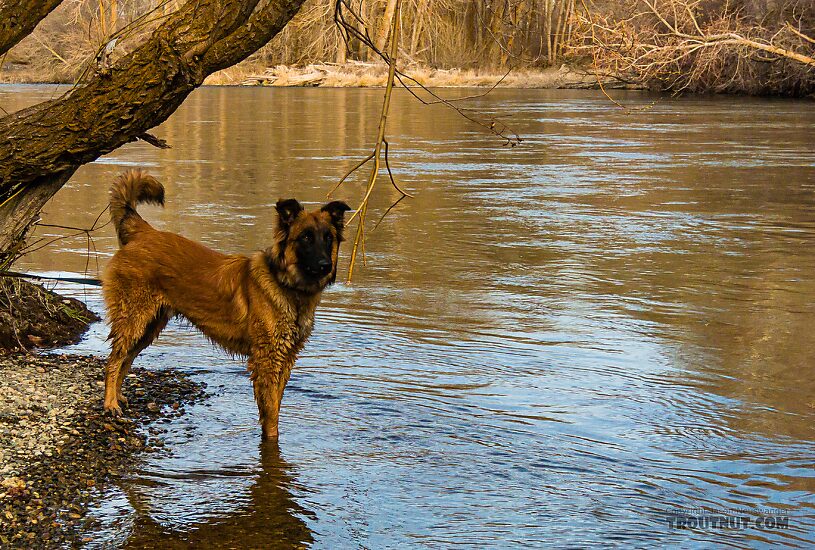
My 7-month-old fishing buddy.
StateWashington
LocationYakima River
Date TakenApr 9, 2021
Date AddedApr 11, 2021
AuthorTroutnut
CameraNIKON 1 AW1
Closeup insects by Troutnut from the Yakima River in Washington
Heptagenia pulla (Golden Dun) Mayfly Nymph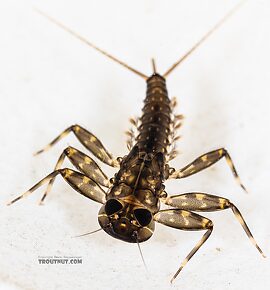 View 11 PicturesThis specimen is interesting because Heptagenia pulla has not been reported from Washington or neighboring states (Saskatchewan is the closest), yet the distinctive key characteristics are clear.
View 11 PicturesThis specimen is interesting because Heptagenia pulla has not been reported from Washington or neighboring states (Saskatchewan is the closest), yet the distinctive key characteristics are clear.
It keys to the genus Heptagenia because the tarsal claw (Tarsal claw: The claws at the tip of the tarsus, on an insect's "foot.") has a single basal (Basal: close to the base; root or beginning) tooth, and the gills on segment 7 have fibrils.
For the species key:
1. The left mandible (Mandible: The paired jaws of an insect which are used for grabbing food, located immediately behind the labrum.) is planate (fairly straight-edged) whereas the right mandible (Mandible: The paired jaws of an insect which are used for grabbing food, located immediately behind the labrum.) is angulate (has one sharp turn on the edge).
2. The labrum (Labrum: The platelike structure forming the roof of the mouth of insects; the upper lip.) is much wider than long.
3. There's a thin light-colored streak lateral (Lateral: To the side.) to the eye on the head.
 View 11 PicturesThis specimen is interesting because Heptagenia pulla has not been reported from Washington or neighboring states (Saskatchewan is the closest), yet the distinctive key characteristics are clear.
View 11 PicturesThis specimen is interesting because Heptagenia pulla has not been reported from Washington or neighboring states (Saskatchewan is the closest), yet the distinctive key characteristics are clear.It keys to the genus Heptagenia because the tarsal claw (Tarsal claw: The claws at the tip of the tarsus, on an insect's "foot.") has a single basal (Basal: close to the base; root or beginning) tooth, and the gills on segment 7 have fibrils.
For the species key:
1. The left mandible (Mandible: The paired jaws of an insect which are used for grabbing food, located immediately behind the labrum.) is planate (fairly straight-edged) whereas the right mandible (Mandible: The paired jaws of an insect which are used for grabbing food, located immediately behind the labrum.) is angulate (has one sharp turn on the edge).
2. The labrum (Labrum: The platelike structure forming the roof of the mouth of insects; the upper lip.) is much wider than long.
3. There's a thin light-colored streak lateral (Lateral: To the side.) to the eye on the head.
Collected April 9, 2021 from the Yakima River in Washington
Added to Troutnut.com by Troutnut on April 12, 2021
Added to Troutnut.com by Troutnut on April 12, 2021
Isoperla fusca (Yellow Sally) Stonefly Nymph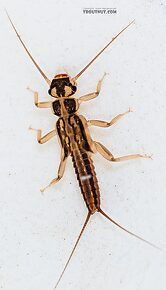 View 12 PicturesThis specimen keys to Isoperla fusca using the key in Szczytko & Stewart 1979, but some species of Isoperla weren't represented there.
View 12 PicturesThis specimen keys to Isoperla fusca using the key in Szczytko & Stewart 1979, but some species of Isoperla weren't represented there.
 View 12 PicturesThis specimen keys to Isoperla fusca using the key in Szczytko & Stewart 1979, but some species of Isoperla weren't represented there.
View 12 PicturesThis specimen keys to Isoperla fusca using the key in Szczytko & Stewart 1979, but some species of Isoperla weren't represented there.Collected April 9, 2021 from the Yakima River in Washington
Added to Troutnut.com by Troutnut on April 12, 2021
Added to Troutnut.com by Troutnut on April 12, 2021
Male Baetis tricaudatus (Blue-Winged Olive) Mayfly Nymph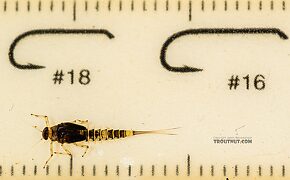 View 14 PicturesThis specimen and many like it were found with other specimens I found to be duller-colored females of the same species. I wasn't aware of such a difference between male and female nymphs in Baetids, but all the morphological characteristics I checked in the key were the same, and the color patterns are, too -- just not the brightness.
View 14 PicturesThis specimen and many like it were found with other specimens I found to be duller-colored females of the same species. I wasn't aware of such a difference between male and female nymphs in Baetids, but all the morphological characteristics I checked in the key were the same, and the color patterns are, too -- just not the brightness.
 View 14 PicturesThis specimen and many like it were found with other specimens I found to be duller-colored females of the same species. I wasn't aware of such a difference between male and female nymphs in Baetids, but all the morphological characteristics I checked in the key were the same, and the color patterns are, too -- just not the brightness.
View 14 PicturesThis specimen and many like it were found with other specimens I found to be duller-colored females of the same species. I wasn't aware of such a difference between male and female nymphs in Baetids, but all the morphological characteristics I checked in the key were the same, and the color patterns are, too -- just not the brightness.Collected April 9, 2021 from the Yakima River in Washington
Added to Troutnut.com by Troutnut on April 12, 2021
Added to Troutnut.com by Troutnut on April 12, 2021
Female Baetis tricaudatus (Blue-Winged Olive) Mayfly Nymph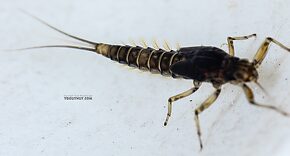 View 13 PicturesThese nymphs were highly abundant in my early April kick net samples from the Yakima Canyon, and one of them emerged into a dun, which I photographed immediately. Similar-looking nymphs but with distinctly brighter color patterns were also abundant. I just photographed one. After extensive views under the microscope, it's clear the bright ones are males and the dull ones are females of the same species.
View 13 PicturesThese nymphs were highly abundant in my early April kick net samples from the Yakima Canyon, and one of them emerged into a dun, which I photographed immediately. Similar-looking nymphs but with distinctly brighter color patterns were also abundant. I just photographed one. After extensive views under the microscope, it's clear the bright ones are males and the dull ones are females of the same species.
The most likely guess at the species is Baetis tricaudatus, which may be a complex of related species that haven't all been sorted out yet. It isn't a perfect fit to every key characteristic (and I never seem to find a Baetis that matches the expected pronotum (Pronotum: The top of the insect prothorax.) color patterns, but that seems to be the closest.
The microscope images here were taken with different specimens from the main photos (so I could dissect them while preserving that one intact), but clearly the same species.
 View 13 PicturesThese nymphs were highly abundant in my early April kick net samples from the Yakima Canyon, and one of them emerged into a dun, which I photographed immediately. Similar-looking nymphs but with distinctly brighter color patterns were also abundant. I just photographed one. After extensive views under the microscope, it's clear the bright ones are males and the dull ones are females of the same species.
View 13 PicturesThese nymphs were highly abundant in my early April kick net samples from the Yakima Canyon, and one of them emerged into a dun, which I photographed immediately. Similar-looking nymphs but with distinctly brighter color patterns were also abundant. I just photographed one. After extensive views under the microscope, it's clear the bright ones are males and the dull ones are females of the same species. The most likely guess at the species is Baetis tricaudatus, which may be a complex of related species that haven't all been sorted out yet. It isn't a perfect fit to every key characteristic (and I never seem to find a Baetis that matches the expected pronotum (Pronotum: The top of the insect prothorax.) color patterns, but that seems to be the closest.
The microscope images here were taken with different specimens from the main photos (so I could dissect them while preserving that one intact), but clearly the same species.
Collected April 9, 2021 from the Yakima River in Washington
Added to Troutnut.com by Troutnut on April 12, 2021
Added to Troutnut.com by Troutnut on April 12, 2021
Female Baetis tricaudatus (Blue-Winged Olive) Mayfly Dun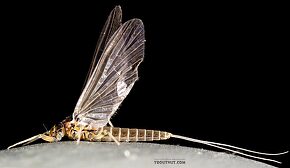 View 9 PicturesThis dun emerged on my desk from a container of nymphs I was sorting, so I was able to get an ID from the nymphs. I also uploaded photos of a female nymph and a male nymph.
View 9 PicturesThis dun emerged on my desk from a container of nymphs I was sorting, so I was able to get an ID from the nymphs. I also uploaded photos of a female nymph and a male nymph.
 View 9 PicturesThis dun emerged on my desk from a container of nymphs I was sorting, so I was able to get an ID from the nymphs. I also uploaded photos of a female nymph and a male nymph.
View 9 PicturesThis dun emerged on my desk from a container of nymphs I was sorting, so I was able to get an ID from the nymphs. I also uploaded photos of a female nymph and a male nymph.Collected April 9, 2021 from the Yakima River in Washington
Added to Troutnut.com by Troutnut on April 11, 2021
Added to Troutnut.com by Troutnut on April 11, 2021
Ephemerella excrucians (Pale Morning Dun) Mayfly Nymph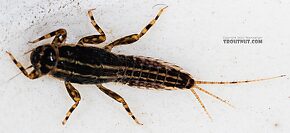 View 10 Pictures
View 10 Pictures
 View 10 Pictures
View 10 PicturesCollected April 9, 2021 from the Yakima River in Washington
Added to Troutnut.com by Troutnut on April 12, 2021
Added to Troutnut.com by Troutnut on April 12, 2021
Helicopsyche borealis (Speckled Peter) Caddisfly Pupa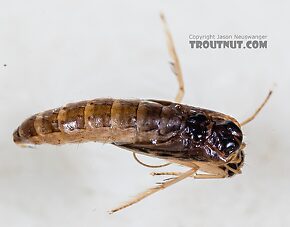 View 13 PicturesI'm calling this one very tentatively Helicopsyche borealis, with some big caveats that I might be wrong.
View 13 PicturesI'm calling this one very tentatively Helicopsyche borealis, with some big caveats that I might be wrong.
It seems to key fairly easily to Helicopsychidae, except at the last couplet in Merritt & Cummins (5th ed) it's supposed to have “anal processes short and straight, each with several mesal (Mesal: Toward the middle.) setae (Seta: Little hairs on insects.) and 2 long apical (Apical: Close to the apex; tip or end.) setae (Seta: Little hairs on insects.),” whereas this one has VERY short, straight processes with 3 long apical (Apical: Close to the apex; tip or end.) setae (Seta: Little hairs on insects.) and no mesal (Mesal: Toward the middle.) ones.
Additionally, the only species of Helicopsychidae documented in this region is Helicopsyche borealis, which is supposed to emerge much later in the summer.
 View 13 PicturesI'm calling this one very tentatively Helicopsyche borealis, with some big caveats that I might be wrong.
View 13 PicturesI'm calling this one very tentatively Helicopsyche borealis, with some big caveats that I might be wrong.It seems to key fairly easily to Helicopsychidae, except at the last couplet in Merritt & Cummins (5th ed) it's supposed to have “anal processes short and straight, each with several mesal (Mesal: Toward the middle.) setae (Seta: Little hairs on insects.) and 2 long apical (Apical: Close to the apex; tip or end.) setae (Seta: Little hairs on insects.),” whereas this one has VERY short, straight processes with 3 long apical (Apical: Close to the apex; tip or end.) setae (Seta: Little hairs on insects.) and no mesal (Mesal: Toward the middle.) ones.
Additionally, the only species of Helicopsychidae documented in this region is Helicopsyche borealis, which is supposed to emerge much later in the summer.
Collected April 9, 2021 from the Yakima River in Washington
Added to Troutnut.com by Troutnut on April 12, 2021
Added to Troutnut.com by Troutnut on April 12, 2021
Ephemerella excrucians (Pale Morning Dun) Mayfly Nymph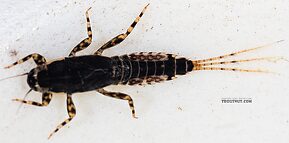 View 9 Pictures
View 9 Pictures
 View 9 Pictures
View 9 PicturesCollected April 9, 2021 from the Yakima River in Washington
Added to Troutnut.com by Troutnut on April 12, 2021
Added to Troutnut.com by Troutnut on April 12, 2021
Pteronarcys californica (Giant Salmonfly) Stonefly Nymph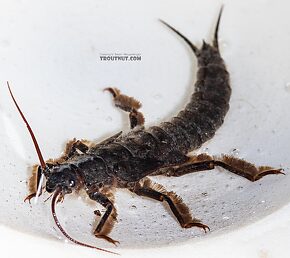 View 5 PicturesThis salmonfly nymph is probably not quite fully grown, as it still has a couple months yet to emerge.
View 5 PicturesThis salmonfly nymph is probably not quite fully grown, as it still has a couple months yet to emerge.
 View 5 PicturesThis salmonfly nymph is probably not quite fully grown, as it still has a couple months yet to emerge.
View 5 PicturesThis salmonfly nymph is probably not quite fully grown, as it still has a couple months yet to emerge.Collected April 9, 2021 from the Yakima River in Washington
Added to Troutnut.com by Troutnut on April 12, 2021
Added to Troutnut.com by Troutnut on April 12, 2021
Ameletus vernalis (Brown Dun) Mayfly Nymph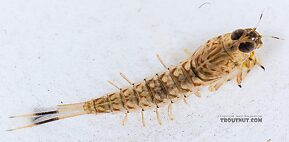 View 9 PicturesI keyed this one out using the Alberta species key from Zloty & Pritchard 1997.
View 9 PicturesI keyed this one out using the Alberta species key from Zloty & Pritchard 1997.
Notes from the ID include:
1. Posterior (Posterior: Toward the back of an organism's body. The phrase "posterior to" means "in back of.") margin of sternites (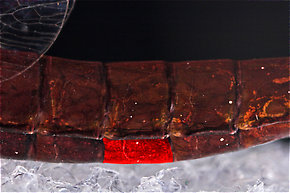 Sternite: The bottom (ventral) part of a single segment on an insect's abdomen.) 6-8 without spines
Sternite: The bottom (ventral) part of a single segment on an insect's abdomen.) 6-8 without spines
2. Mesal (Mesal: Toward the middle.) gill extension "well developed"
3. Basil third of caudal (Caudal: Toward the posterior tip of the body.) filaments pale
4. Anterior (Anterior: Toward the front of an organism's body. The phrase "anterior to" means "in front of.") surface of front femora (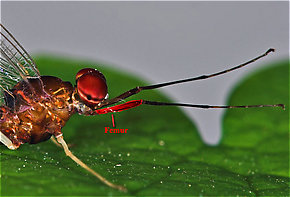 Femur: The main segment of an insect's leg close to the body, in between the tibia and the trochanter.) mostly pale
Femur: The main segment of an insect's leg close to the body, in between the tibia and the trochanter.) mostly pale
5. Dark band on caudal (Caudal: Toward the posterior tip of the body.) filaments begins around segment 20
6. Final instars (Instar: Many invertebrates molt through dozens of progressively larger and better-developed stages as they grow. Each of these stages is known as an instar. Hard-bodied nymphs typically molt through more instars than soft-bodied larvae.) early season
This one keys out pretty cleanly to Ameletus vernalis except the color pattern on the tergites (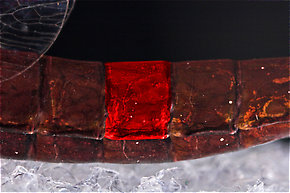 Tergite: The top (dorsal) part of a single segment on an insect's abdomen when it consists of a single chitinous plate (sclerite), or an individual sclerite if the segment has more than one.) doesn't match. However, two species known in Washington aren't included in the key. Of those two, Ameletus vancouverensis would be too small (adult body length 9 mm), but Ameletus andersoni (currently documented only from a spring in Cowlitz County) has a wide range of sizes and emergence times that could be compatible with this one. So I can't rule that species out, but Ameletus vernalis seems the most likely.
Tergite: The top (dorsal) part of a single segment on an insect's abdomen when it consists of a single chitinous plate (sclerite), or an individual sclerite if the segment has more than one.) doesn't match. However, two species known in Washington aren't included in the key. Of those two, Ameletus vancouverensis would be too small (adult body length 9 mm), but Ameletus andersoni (currently documented only from a spring in Cowlitz County) has a wide range of sizes and emergence times that could be compatible with this one. So I can't rule that species out, but Ameletus vernalis seems the most likely.
 View 9 PicturesI keyed this one out using the Alberta species key from Zloty & Pritchard 1997.
View 9 PicturesI keyed this one out using the Alberta species key from Zloty & Pritchard 1997. Notes from the ID include:
1. Posterior (Posterior: Toward the back of an organism's body. The phrase "posterior to" means "in back of.") margin of sternites (

One sternite of this Isonychia bicolor mayfly spinner is highlighted in red.
2. Mesal (Mesal: Toward the middle.) gill extension "well developed"
3. Basil third of caudal (Caudal: Toward the posterior tip of the body.) filaments pale
4. Anterior (Anterior: Toward the front of an organism's body. The phrase "anterior to" means "in front of.") surface of front femora (

The femur of this Isonychia bicolor mayfly spinner is highlighted in red.
5. Dark band on caudal (Caudal: Toward the posterior tip of the body.) filaments begins around segment 20
6. Final instars (Instar: Many invertebrates molt through dozens of progressively larger and better-developed stages as they grow. Each of these stages is known as an instar. Hard-bodied nymphs typically molt through more instars than soft-bodied larvae.) early season
This one keys out pretty cleanly to Ameletus vernalis except the color pattern on the tergites (

One tergite of this Isonychia bicolor mayfly spinner is highlighted in red.
Collected April 9, 2021 from the Yakima River in Washington
Added to Troutnut.com by Troutnut on April 12, 2021
Added to Troutnut.com by Troutnut on April 12, 2021
Most recent comments on this post (latest on top)
| Adirman | April 14th, 2021, 11:27 am | |
| Monticello, NY Posts: 505 | Sorry No pics to share as I don’t carry my phone into the water , but I got my first of the season today as well: a nice 12” Brown! Caught him Czech Nymphing on the point fly , a # 6 stone fly 😊 | |
| Martinlf | April 13th, 2021, 11:41 am | |
Moderator Palmyra PAPosts: 3233 | Nice photos. Glad to hear you got your vaccination. My second dose of the Moderna vaccine comes Monday. Getting ready to travel and fish! Fishing has been good in Pennsylvania, with olives and grannoms, but we just had some storms that blew everything out locally. Waiting for levels to drop. | |
| "He spread them a yard and a half. 'And every one that got away is this big.'" --Fred Chappell | ||
| Partsman | April 13th, 2021, 3:03 am | |
| bancroft michigan Posts: 420 | Beautiful pictures as usual. Mike. | |
| Wbranch | April 12th, 2021, 3:58 pm | |
| York & Starlight PA Posts: 2733 | I wouldn't wade it without a PFD collar. | |
| Catskill fly fisher for fifty-five years. | ||
| Millcreek | April 12th, 2021, 11:27 am | |
| Healdsburg, CA Posts: 356 | Enjoying your photos, especially of the insects. Photos of identifying characteristics are quite interesting. | |
Comment on this post
Top 10 Fly Hatches
Top Gift Shop Designs
Eat mayflies.
Top Insect Specimens
Miscellaneous Sites
Troutnut.com is copyright © 2004-2024 Jason
Neuswanger (email Jason). See my FAQ for information about use of my images.
 privacy policy
privacy policy




